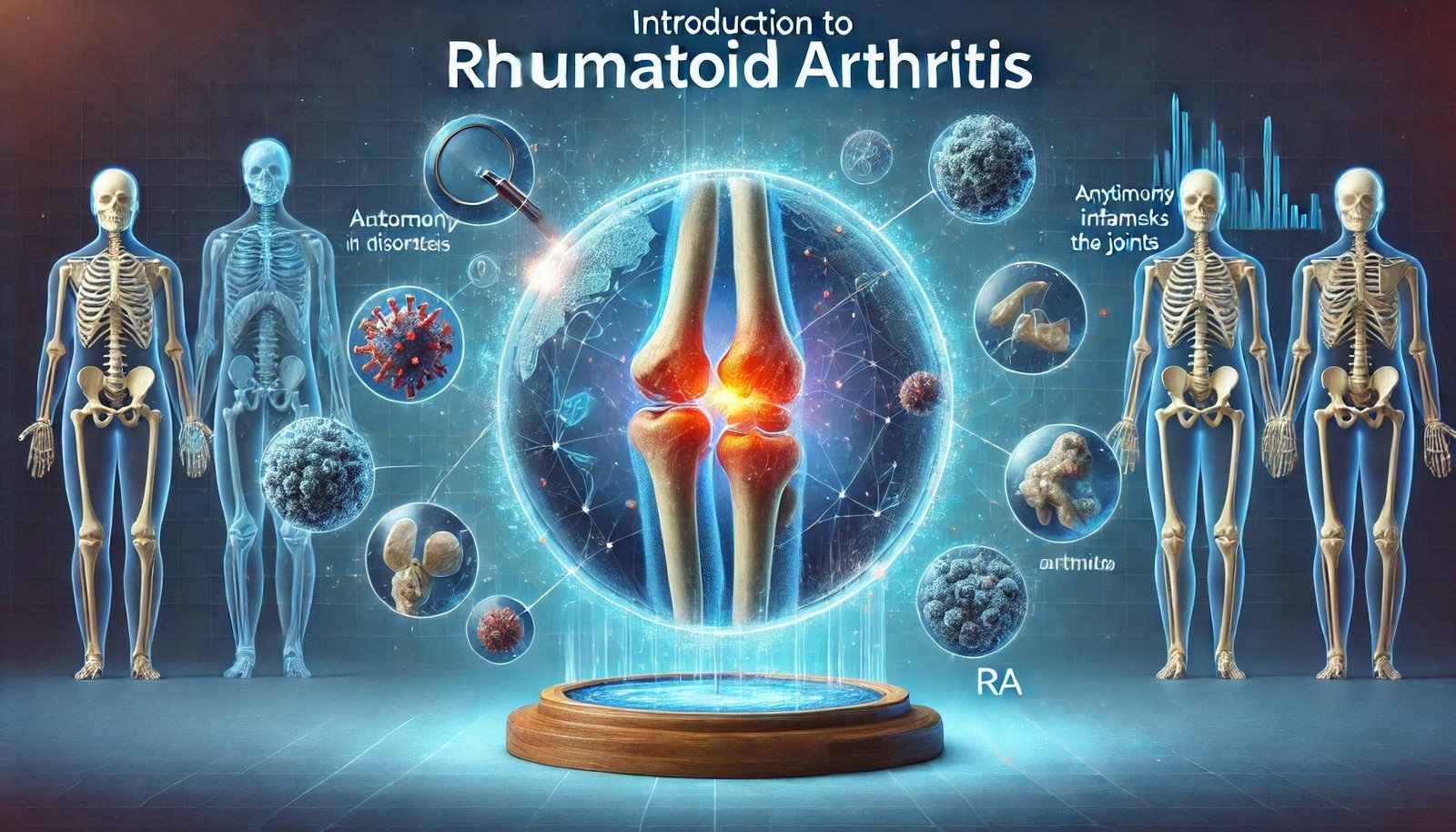
Introduction to Rheumatoid Arthritis
Rheumatoid arthritis (RA) is a chronic inflammatory disorder that primarily affects the joints but can also have systemic implications. It is an autoimmune condition, where the immune system mistakenly attacks the synovium—the lining of the membranes that surround the joints. This leads to inflammation, swelling, and pain, often resulting in significant joint damage over time. The impact of rheumatoid arthritis can vary considerably among individuals, with factors such as genetics, environment, and overall health playing roles in the disease’s progression and severity.
Rheumatoid arthritis is generally categorized into three distinct stages: mild, moderate, and severe. In the mild stage, individuals may experience sporadic flare-ups characterized by minor pain and stiffness, often manageable with over-the-counter medications. The moderate stage typically includes more frequent symptoms, where patients may require prescription anti-inflammatory drugs to alleviate discomfort and prevent further joint inflammation. Finally, in the severe stage, the symptoms become debilitating and erosive, potentially leading to significant joint deformity and incapacitation without aggressive treatment.
It is important to note that there is no standardized timeline for the progression of RA. The rate at which the condition advances can differ markedly from patient to patient, influenced by factors such as treatment adherence and lifestyle choices. Initially, some individuals may face painful symptoms that resolve temporarily, while others may see these symptoms persist or worsen over time. Consequently, understanding rheumatoid arthritis requires a comprehensive view of its impact on daily life and the necessity for prompt intervention to mitigate long-term effects. As research continues, new treatment options are being developed, offering hope for improved management of this complex disease.
The Importance of Early Detection and Treatment
Rheumatoid arthritis (RA) is a chronic inflammatory disorder that can significantly affect the joints and other parts of the body. The early detection and treatment of RA are vital for managing the disease effectively and improving the patient’s quality of life. Symptoms can manifest differently among individuals, which adds complexity to early diagnosis. Common initial signs include joint pain, stiffness, tenderness, and swelling, especially in the mornings. However, some individuals might experience systemic symptoms such as fatigue, fever, or weight loss. This variability emphasizes the necessity for patients to be vigilant and proactive when it comes to their health.
Recognizing early symptoms requires individuals to be aware of their bodies and any changes therein. Due to the nature of RA, delaying medical consultation can lead to irreversible joint damage and increased disability. Early treatment interventions often involve the use of disease-modifying anti-rheumatic drugs (DMARDs) that can slow the progression of the disease and prevent joint erosion. Prompt medical attention not only improves physical outcomes but also has a significant psychological impact, reducing anxiety related to potential complications.
Furthermore, healthcare professionals play a crucial role in the early stages of RA management. A thorough assessment can lead to a timely diagnosis and a tailored treatment plan based on individual patient needs. This might include lifestyle modifications, physical therapy, and regular monitoring of disease activity. By prioritizing early detection, both patients and healthcare providers can work collaboratively to address the challenges posed by rheumatoid arthritis. This partnership is essential for achieving better health outcomes and enhancing the overall well-being of those affected. Ultimately, understanding the importance of early intervention in RA will empower individuals to seek the necessary care and resources they need in their journey towards managing the condition.
Stages of Rheumatoid Arthritis: An Overview
Rheumatoid arthritis (RA) is a chronic inflammatory disorder that affects the joints and can lead to significant physical changes over time. Understanding the stages of rheumatoid arthritis is crucial for effective management and treatment. The progression of this disease is typically categorized into four stages: stage 1 (the initial stage), stage 2 (the moderate stage), stage 3 (the severe stage), and stage 4 (the end-stage).
In stage 1, individuals may experience mild inflammation in the joints, often accompanied by swelling and stiffness. Early signs may be subtle and could be mistaken for regular fatigue or exertion. At this juncture, the body’s immune system begins to attack the synovial membrane, the soft tissue lining the joints, leading to the first symptoms. The primary treatment goals during this stage focus on reducing inflammation to prevent further progression.
As RA advances to stage 2, joint damage becomes more apparent. Patients often experience increased pain and stiffness, particularly affecting small joints such as those in the hands and feet. This stage is characterized by more noticeable joint inflammation on imaging studies, and treatment might involve more aggressive interventions aiming to slow down the disease progression and manage pain effectively.
By stage 3, the physical changes are significant as joint deformities may start to develop. Individuals might face challenges with mobility, and daily activities become increasingly difficult. The treatment at this stage often requires a combination of medication, physical therapy, and lifestyle adjustments with a focus on preserving joint function.
Finally, in stage 4, the disease culminates in severe joint damage and loss of function. At this point, the focus of treatment transitions to pain management and improving quality of life, as the potential for reversing joint damage diminishes significantly. A comprehensive understanding of these stages is essential for both patients and healthcare providers to effectively navigate the complexities of rheumatoid arthritis.
Stage 1: Early-Stage Rheumatoid Arthritis
Rheumatoid Arthritis (RA) is a chronic autoimmune disorder that predominantly affects the joints, leading to discomfort and inflammation. In Stage 1 of RA, individuals may begin to experience early symptoms that signal the onset of this condition. During this initial phase, joint pain and stiffness are commonly reported, often occurring in the morning after prolonged periods of inactivity. This stiffness can last for more than thirty minutes, marking it as distinct from the stiffness associated with other types of arthritis.
Inflammation in the joints serves as a hallmark of early-stage RA. Patients might notice swollen joints, particularly in the hands, wrists, and feet. The inflammatory process can happen symmetrically, meaning that if one knee is affected, the other likely will be too. Fatigue is another prominent symptom experienced during this stage, and many individuals report a general sense of malaise. This fatigue can significantly impact daily living, making routine tasks seem burdensome.
Recognizing these early symptoms is crucial, as early-stage RA can potentially lead to more severe complications if left untreated. It is highly advisable for individuals exhibiting these signs to consult a healthcare professional promptly. Early intervention may include medication, lifestyle modifications, and physical therapy, which can help manage symptoms and slow disease progression. Implementing treatment plans and adjusting daily habits during this stage can be pivotal in improving quality of life and mitigating further joint damage. Understanding the crucial nature of early-stage RA enables individuals to take proactive measures toward achieving healthier outcomes.
Managing Progression with Effective Treatments
Rheumatoid arthritis (RA) is a chronic inflammatory disorder that affects the joints and can result in significant disability if left unmanaged. As the disease progresses, effective treatment options become crucial in alleviating symptoms and slowing down the degeneration of joint tissues. Recent advancements in RA therapy have introduced a variety of options, making it vital for patients to consider personalized treatment plans tailored to their specific needs.
The cornerstone of managing RA typically involves the use of disease-modifying antirheumatic drugs (DMARDs). These medications work by inhibiting the inflammatory processes that contribute to joint damage. Traditional DMARDs, such as methotrexate, remain popular choices; however, biologic agents are increasingly gaining attention due to their targeted mechanisms that address specific components of the immune response involved in RA. Examples include tumor necrosis factor (TNF) inhibitors and interleukin-6 inhibitors, which have shown promise in reducing inflammation and halting disease progression.
In addition to pharmacological interventions, clinicians emphasize the importance of non-pharmacological strategies. Physical therapy plays a crucial role in maintaining joint function, enhancing flexibility, and minimizing stiffness. Lifestyle modifications, such as adopting a balanced diet rich in omega-3 fatty acids and antioxidants, can also support overall joint health. Regular exercise is encouraged, as it not only promotes physical fitness but also helps in managing stress levels, which can exacerbate symptoms.
Moreover, ongoing assessment and regular consultations with healthcare professionals allow for the adjustment of treatment plans as the disease evolves. The efficacy of a treatment can vary widely from patient to patient; therefore, a personalized approach enables better management of symptoms and overall health. By staying proactive in their treatment, individuals living with RA can navigate their condition more effectively, maintaining a higher quality of life.
The Role of Lifestyle Changes in Managing RA
Rheumatoid arthritis (RA) is a chronic inflammatory disorder that primarily affects the joints, leading to pain, stiffness, and swelling. While medical treatments such as anti-inflammatory medications and disease-modifying antirheumatic drugs (DMARDs) are essential for managing RA, lifestyle changes also play a significant role in the overall management of this condition. By making informed choices, individuals living with RA can improve their quality of life and potentially alleviate some symptoms.
Dietary adjustments serve as an important aspect of lifestyle management for those with RA. A balanced diet rich in fruits, vegetables, whole grains, and lean proteins can help support immune function and reduce inflammation. Specific foods, such as omega-3 fatty acids found in fish, nuts, and seeds, have been noted for their anti-inflammatory properties. Conversely, individuals may benefit from avoiding processed foods, refined sugars, and excessive saturated fats, which can trigger inflammation. Keeping a food diary can also help identify any food sensitivities that may exacerbate RA symptoms.
Regular physical activity is another critical component of managing RA. Engaging in low-impact exercises such as swimming, cycling, or yoga allows patients to maintain joint flexibility and strengthen surrounding muscles without putting excessive strain on the joints. A tailored exercise routine, created with the guidance of healthcare professionals, can enhance physical fitness while mitigating pain and stiffness associated with RA. Additionally, incorporating gentle stretching routines can help improve joint movement and overall well-being.
Stress management practices, including mindfulness, meditation, and deep-breathing exercises, can significantly influence RA symptoms. Stress is known to exacerbate inflammation and increase pain levels, hence employing strategies to manage stress effectively can lead to a reduction in RA flare-ups. Establishing a support network through family, friends, or support groups can also be beneficial in coping with the emotional challenges posed by living with a chronic condition. In conclusion, incorporating lifestyle changes alongside medical treatment can provide a comprehensive approach to managing rheumatoid arthritis, enhancing both physical and emotional health.
Conclusion: Empowering Your Health with Knowledge
Understanding rheumatoid arthritis (RA) is essential for individuals affected by this chronic condition. Knowledge equips patients to manage their health effectively and engage actively with their healthcare teams. By being informed about the stages and symptoms of rheumatoid arthritis, patients can recognize early warning signs and act promptly. Greater awareness leads to timely interventions, which can significantly improve quality of life.
Education about treatment options is equally vital. Today, there are various therapies available for managing rheumatoid arthritis, ranging from medications to lifestyle adjustments. Patients should feel empowered to discuss these options with their healthcare providers. Open dialogues can help tailor a treatment plan that aligns with individual needs and preferences, ensuring that patients are not merely passive recipients of care but active participants in their health journey.
Moreover, staying updated on the latest research and advancements in rheumatoid arthritis treatments can further enhance patient empowerment. Many resources, including reputable medical websites and support groups, offer valuable information that helps individuals gain insights into their condition. Joining a community of others with similar experiences can provide emotional support and share practical coping strategies.
In summary, actively seeking knowledge about rheumatoid arthritis, understanding treatment options, and maintaining open communication with healthcare professionals are crucial steps in managing this condition. Empowering oneself with information not only facilitates better health outcomes but also fosters a sense of control over one’s health journey. It is vital to remember that while RA poses challenges, patients can take charge of their health with the right tools, support, and determination.



